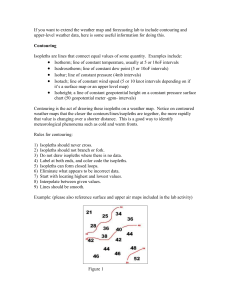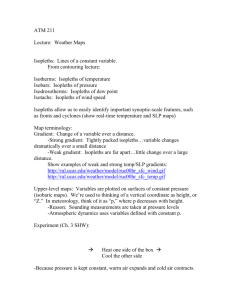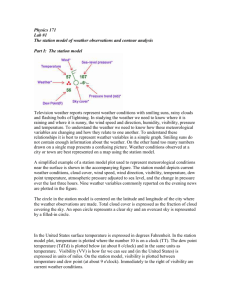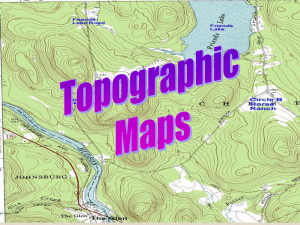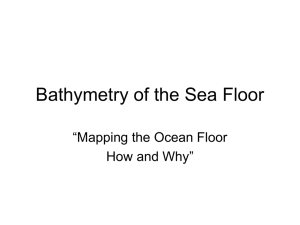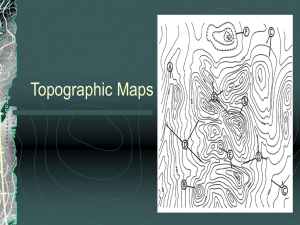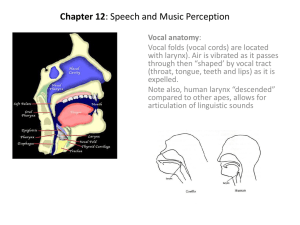Contour analysis
advertisement
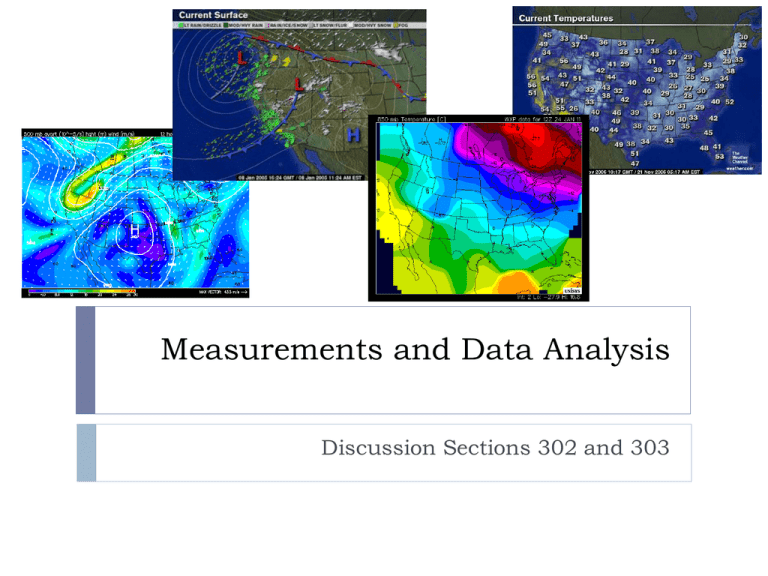
Measurements and Data Analysis Discussion Sections 302 and 303 Weather Discussion NCEP NAM Model Surface/Precip 1200Z 850 mb/Temp 1200Z 300 mb/Wind speed 1200Z 850-800 mb/Relative Humidity 1200Z Radar/Satellite Current Radar Loop Current Satellite Loop Current Water Vapor Loop Forecast Observations and Measurements Station models Observations are taken simultaneously across the nation several times a day Observations taken at a particular weather station Ensures accuracy of forecast models Now that we have our observations, what do we do? There are some missing points in-between the observations Large variations in those observations from place to place We need to contour! Coordinated Universal Time (or Zulu Time) Atmospheric scientists use a coordinated universal time (UTC) Z stands for Zulu Examples 0800Z 1531Z 2130Z Essentially the same as Greenwich Mean Time (GMT) Converting from UTC Central Standard Time (CST) Central Daylight Time (CDT) November 7th 2010 - March 13th 2011 before 2 am March 13th 2011 after 2 am – November 6th 2011 How to convert to CST and CDT CST Subtract 600 from the time Ex. 1700Z – 600 = 1100 (which is 11 am) CDT Subtract 500 from the time Ex. 2100Z – 500 = 1700 (which is 5 pm) Weather Maps Importance of contoured maps Easy diagnosing and depicting weather features and variables Ex. Predicting atmospheric fronts, hurricanes, storms, etc. Give easy-to-read, general information about small to large areas Contouring Contouring is the process of drawing isopleths An isopleth is a line of equal value iso – equal pleth – value A contour analysis involves drawing multiple isopleths Each isopleth has a different name depending on the contour analysis Common Isopleths Isopleth Name Isopleth Meaning Isobar Pressure Isotherm Temperature Isotach Wind Speed Isogon Wind Direction Isopycnic Density Isodrosotherm Dew Point Isohyet Precipitation Accumulation Isohume Humidity Isoshear Wind Shear Isohaline Salinity Isoneph Cloudiness Isohel Sunshine How to Contour Interpolate between given values to correctly place an isopleth Think about the contour as a line separating the observations with higher values on one side of the line, and lower values on the other side 5 5 How to Contour Locate regions of high and low values first Example 15 Draw the 15 °F isotherm 15 How to Contour Contour at evenly spaced increments Example 75 Draw the 75 °F and 80 °F isotherms 75 80 80 Circlular Isopleths Sometimes, you will find the values are localized 20 In this case, you 20 would draw a circle Draw the 20°F and 25 °F isotherms 20 25 25 How to Contour Isopleths cannot touch or cross Isopleths cannot branch or fork 10 9 7 8 9 6 5 8 11 10 6 9 8 7 11 11 9 10 12 11 7 10 10 10 9 7 10 NO! How to Contour Do not create contours where there is an absence of data Preparing to Contour Search for continuity (time and space) on the weather map Survey the map and look for: Eliminate what appears to be faulty or incorrect data Ex: a 95 is found amongst 50s Areas of rapid change (large gradients) Steady areas (flat field) Review data to determine isopleth spacing Will you need to squeeze isopleths tightly? Will you have room to label the isopleths? Contouring Tips Use a pencil Draw smooth lines Be neat and accurate Label the isopleths In-Class Examples Draw the 25°F - 50°F isotherms at 5°F intervals. 25 30 35 40 25 30 35 40 45 45 50 50 In-Class Examples Draw the isobars at 4 mb intervals, starting at 1000 mb . Station Pressure Example Only focus on the pressure Remove stations that do not have a pressure reading Convert 3 digit numbers to actual pressure Remember, 032 => 1003.2 mb There are two of them Draw lines at 4 mb increments above 1000 mb 1004 mb, 1008 mb, 1012 mb, 1016 mb, etc.
